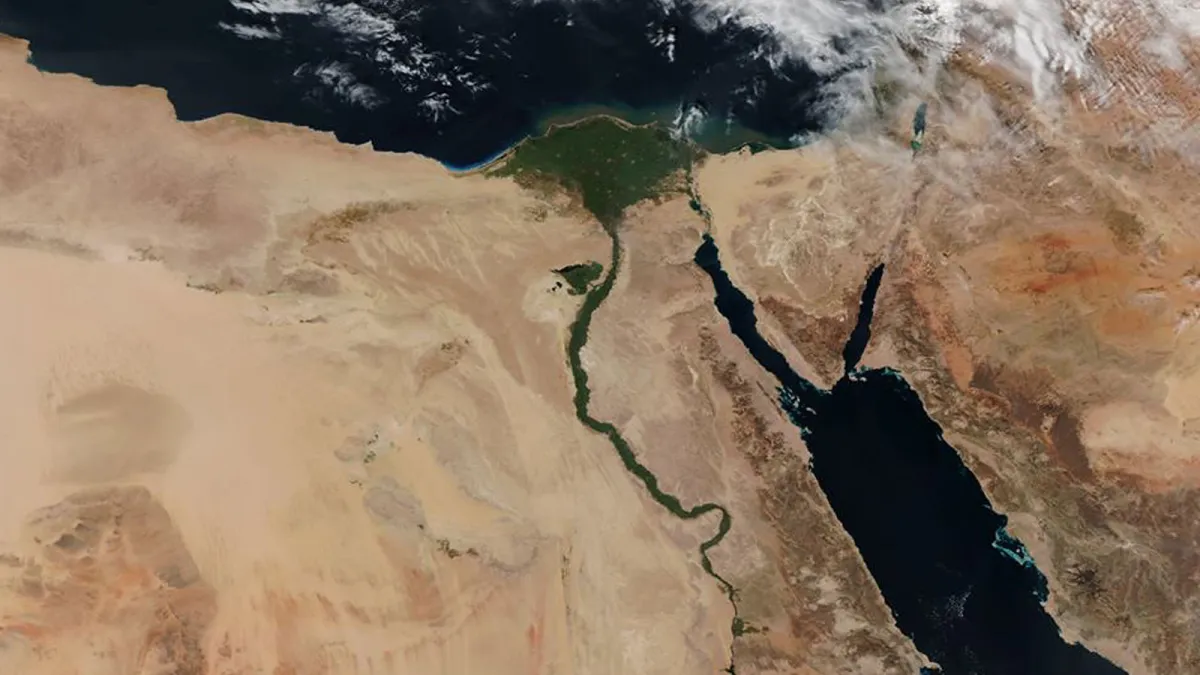Written by: Jennifer Marlon and Joseph Manning
Cleopatra wouldn’t have seen the clouds of ash darken the sky from her throne in Alexandria, but the effects of the eruption of an Alaskan volcano rippled through Egypt and the rest of the ancient world in 43 BCE.
We are part of an interdisciplinary research team that is detailing the fingerprints of that eruption, which set a series of global climate changes in motion during the first century BCE, one of the most critical political transition periods in the history of Western civilization.
Our work is revealing how a single event occurring at a specific location can trigger a powerful cascade of changes that can unravel across continents and seas – affecting not only plants and animals, but also the social, political, and economic dynamics of human societies.
An eruption 6,000 miles from Alexandria
In one of the most remote places on Earth, the Aleutian Island chain in the north Pacific Ocean, in the winter of 43 BCE, Mount Okmok erupted. It was the largest eruption in the Northern Hemisphere in the last 2,500 years. It produced a sudden and massive drop in global temperatures that persisted for a decade.
Tree ring records from the White Mountains of California mark the decade between 43 and 33 BCE as the second-coldest in the Northern Hemisphere in human history. Italy endured severe cold summers that disrupted agriculture and military campaigns.
And in Egypt, the Nile failed to flood for several years in a row.
When people in the region speak of the Nile today, they bring their fist to their heart, indicating the incalculable importance of its water for the existence of life in the desert.
Before the Aswan and other dams were built in the 19th and 20th centuries, the regular summer flooding of the Nile River made farming possible, and civilization flourished along its banks. So important was the flood that a large measuring device called a Nilometer was constructed to track the water’s height along the river. The information was communicated throughout the region so that planting could be synchronized with the timing and magnitude of the coming flood. In years of good flood, Egypt was the wealthiest grain-bearing land in the world.
By contrast, prolonged poor summer flooding on the Nile was associated with famines, riots, disease outbreaks, reactive tax and trade policies, and food price spikes, often contemporaneous with large-scale organized revolts, according to our peer-reviewed research.
Unfortunately for Cleopatra, Mount Okmok erupted at a time when her regime was politically vulnerable.
In 48 BCE, the Roman general Pompey, seeking refuge and a friendly welcome in Egypt after a disastrous battle opposing Julius Caesar, was murdered within sight of Alexandria. Soon after, Cleopatra formed an alliance with Caesar. Cleopatra needed a Roman ally, and the royal treasury was running extremely low. But then came the Ides of March in 44 BC, when Caesar was assassinated in front of the Roman Senate – a political shock for both Rome and Egypt. Cleopatra, dreaming of reinvigorating the great Ptolemaic empire, turned to another Roman general, Marc Antony.
But then the Alaskan volcano erupted.
Although little historical evidence survives from the 30s BC, recovery from famine and disease would not have been quick. By 31 BCE, the Roman Empire had replaced both the Roman Republic and Cleopatra’s Ptolemaic Kingdom.
A new view of the ancient world
In telling the story of the Hellenistic Era, which took place between about 320 and 30 BCE in the greater Mediterranean, historians have described the details of competitive state- and city-building, large-scale wars and cultural change, and economic and technological achievements. These historical narratives have almost always hinged on the decisions of kings and high-level political actors.
A much lesser-known thread woven throughout many of these histories is the story of climate change. New research on the role of climate change during this period is recasting some of the core assumptions of this pivotal period and emerges as disturbingly pertinent to our modern world.
The work of scientists and historians rarely intersect, but as global temperatures continue to rise, questions about the interactions between society and the climate are becoming more pressing. In academia, more interdisciplinary teams are forming to study these interactions. Learning how to integrate knowledge from different disciplines is vital to these collaborations.
Historians of ancient Egypt rely especially on papyri, paper made from the papyrus plants that were plentiful along the banks of the Nile River. This paper retained ink without blurring or smudging. The dry climate helped preserve papyri for millennia, yielding incredibly detailed historical evidence in books, correspondence, and legal documents. While our team’s historians translated and analyzed the ancient papyri, the climate scientists developed reconstructions and models of past climate changes on physical, chemical, and biological evidence from ice and sediment cores, tree rings, and mineral deposits in caves.
By aligning the timelines of changes from the different sources and disciplines, the research team linked the unique geochemical signature of the Okmok eruption in six precisely dated Arctic ice cores to the abrupt cooling and drought in the 30s BCE in the Mediterranean.
How volcanic eruptions change the climate
The Okmok eruption injected sulfur dioxide into the stratosphere, where winds are strong, causing the aerosols to circle the planet. Like a giant umbrella, the aerosols reduced the amount of sunlight that reached Earth’s surface. That led to cooler temperatures and a shift in the typical location of high- and low-pressure systems. Because these pressure systems steer wind circulation and rainfall patterns, climate conditions around the world changed dramatically.
The impacts of sulfur dioxide aerosols have been observed during recent eruptions such as Mount Tambora in 1816 and Pinatubo in 1991, which lowered Earth’s overall temperature by more than 1 degree Celsius for many weeks and even months at a time in some areas. The Tambora eruption in Indonesia led to what is known as the Year Without a Summer, when frosts and lack of sunshine killed crops in New England and throughout Europe.
Climate models now confirm that given the right initial conditions, large-magnitude eruptions can even shift the position of the northern jet stream. Eruptions can also alter the seasonal migration of the Intertropical Convergence Zone, known as the ITCZ, the equatorial band of converging trade winds that drives wet season timing and duration along its southern edge in Africa. These cascading effects are likely what caused the Nile flood failures during Cleopatra’s day.
Although burning coal, oil, and methane gas is the cause of modern-day climate change — not a volcanic eruption — the effect is no less complicated or dangerous. Excess heat can be just as deadly both to crops as cooling caused by reduced sunlight.
As climate scientist Wally Broecker once said, “Climate is an angry beast, and we are poking at it with sticks.” The powerful impacts of a destabilized climate system have the potential to reshape our society. In our own time of human-caused climate change, the stories of history don’t feel quite so ancient.
Header Image Credit: NOAA/NASA
This article originally appeared on Yale Climate Connections







